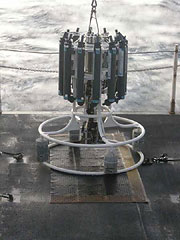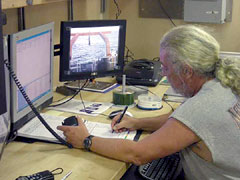

 | |||||||
|
|
Journals 2007/2008Heather Judkins
November 12, 2007 This day started with the sun rising and the CTD dropping into the water for the morning sampling adventure. The action began at 0557 as the crew, Peter, Mike, and Lacey coordinated with the bridge to drop the CTD (conductivity, temperature, and depth device) at the coordinates for the daily drop. Mike and Peter were responsible for using the A-frame winch to lower it into the water to 1000 m. Lacey, from the dry lab, monitored the computer to ensure the real time signal was being received. Using hand-held radios, they then slowly raised the 12 bottle system while "firing" the bottles shut at various depths all the way to the surface. This is where Ryan (physical oceanographer) and I collected the water samples from each of the 12 bottles for filtering. The filtering process is the same process used for the collection of the chlorophyll samples I have already discussed. This gives another profile of the water column down to 1000 m. This depth is the baseline because the thermocline would not occur any deeper than this.  I am interviewing various crew and scientists about their jobs and will highlight them through my journal. While the CTD was descending (takes almost 20 minutes), I found the perfect time to trap Lacey O'Neal while he was at his computer station. He is the Senior Survey Technician for the McArthur II and he is responsible for the maintenance, calibration, and repair of the CTD and all other sensors aboard the ship. Other sensors onboard include the barometer, depth sounder, wind speed and direction, and wire angles. He also runs the SCS, the Science Computing System which is a NOAA program. He generates the displays of the real time data for various stations on the ship- bridge, fly bridge, lower deck, and science stations. This information is used frequently each day for each of the projects running throughout the trip.  Lacey has been working with NOAA for the past 10 years. Prior to that, he was an Army paratrooper. He has been with the McArthur II for 7 years. Qualifications for the job include computer skills, knowledge of the computer programs and science equipment. Overlying any of those however, is the desire to be at sea for long periods of time yearly. The starting salary for this position ranges from $20k-$40k depending on degree and experience. Lacey feels the biggest challenge is the length of time out at sea during the year for the crew. The home port for the McArthur II is in Seattle, Wa and he has a home just outside of it. The ship is in port from mid-December through mid-March. The crew on this ship doesn't see home for 10 months. He feels the most interesting thing about being onboard is the diversity of scientists and crew that come together for the projects that are run throughout the year. The projects are mostly NOAA projects from their fisheries and marine sanctuary sections which apply for ship time and then wait for the schedule for the year. Marine Science Questions: 1. Why do you think it is important to have the CTD dropped at the same latitude and longitude for each waypoint(start and end point each day) for the entire 4 months of the study? 2. Could you be out at sea for 10 months a year? Why or why not? (at least 1 paragraph) |
||||||